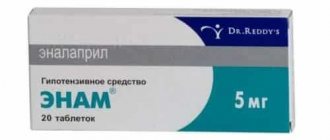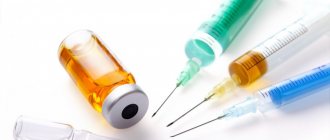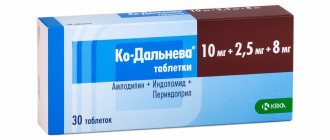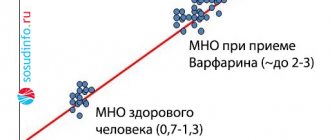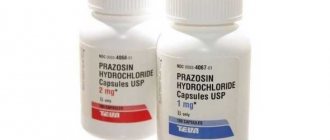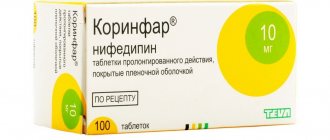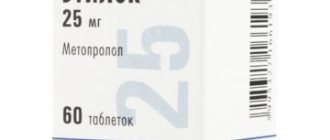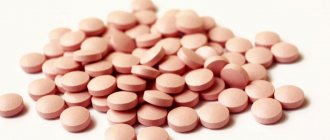What is Digoxin?
The medication Digoxin is a drug that is actively used to treat cardiac arrhythmias and heart failure. The medicine belongs to the group of purified glycosides. Digoxin directly affects the contraction of the heart muscle, increasing it. This effect increases cardiac output in failure. Moreover, when the heartbeat is irregular, the drug slows down and normalizes it.
Active substance
The drug belongs to the group of cardiac glycosides. Available in the form of tablets and ampoules with a concentration of 0.25 mg. The main substance, digoxin, is obtained by extraction from the plant Foxglove (Digitalis). Additional components depend on the manufacturer: potato starch, talc, calcium stearate, glucose or sucrose, talc and petroleum jelly.
Cardiotonics contribute to the manifestations of:
- pronounced positive dynamics of the ionotropic effect;
- an increase in the contractile force of the heart muscles due to an increase in the concentration of Ca+ ions in cardiomyocyte cells;
- reducing the need for additional oxygen enrichment of the myocardium;
- increased stroke volume;
- reduction of dromotropic, chronotropic effects;
- normalization of the frequency of impulse generation by the sinus node.
As a result, the speed of impulse conduction in the atrioventricular system decreases, the activity of the vagus nerve in the heart muscles increases, affecting the sinortrial node. The substance indirectly affects the receptors of the aorta.
Due to this effect of Digoxin, a decrease in heart rate is achieved in cases of diagnosis of “supraventricular tachyarrhythmia” (constant, paroxysmal form or flutter).
The drug name Digoxinium was originally owned by the Hungarian pharmaceutical company Gideon Richter.
If there is heart failure due to congestion, then the medicine has a vasodilatory effect. The overall resistance of the periphery of the vascular bed decreases, shortness of breath decreases, and the volume of edema decreases.
Digoxin Pharmland 0.25 mg No. 50 or Grindeks (made in Latvia) are considered recognized releases among doctors. The dosages are the same, the active ingredient is the same.
Release form
The drug Digoxin is produced in the form of tablets, ampoules with a solution for intravenous administration:
- The tablets are white in color and have a flat cylindrical shape. On one side is the letter “D”. A contour package with cells contains 10 pieces each, and a cardboard pack contains from 1 to 5 such cells. 50 tablets can be in polymer or glass jars; they are sold in a cardboard pack in quantities of 1 or 2 pieces. The same thing happens with polypropylene pencil cases.
- The solution for intravenous administration is produced in 5 ampoules in contour packaging with cells, which are in a cardboard pack of 1 or 2 pieces.
Pregnancy and lactation
Cardiac glycosides (Digitoxin, instructions for use) can be used during pregnancy in case of heart failure and as a means of preventing arrhythmia in the mother or fetus.
During digoxin therapy, the mother can breastfeed her baby. Digoxin passes into breast milk in low concentrations. Concentrations in a child's blood are so low that they rarely cause long-term complications.
There is nothing negative about digoxin during pregnancy and lactation, but therapy should be monitored in the first months.
Mechanism of action
Digoxin is a herbal drug that has a strong cardiotonic effect, so its use increases stroke and minute blood volume, and the need of myocardial cells for oxygen is reduced. Heart muscle contraction improves after taking Digoxin. In addition, the medication increases the severity of the negative dromo- and chronotropic effect - the sinus node reduces the frequency of generation of an electrical impulse and the speed of its conduction through the cardiac system, and the activity of the sinoatrial node slows down.
Effectiveness of influence on the myocardium in case of rhythm disturbances
The slowing of heart rate under the influence of Digoxin occurs due to direct and indirect effects on the myocardium. In the first case, there is a direct decrease in the excitability of the sinus node, which reduces the number of impulses it produces.
The indirect effect of the drug has a reflex mechanism of action. It consists of the following reactions:
- Stimulation of receptors in the aortic arch and carotid sinus activates the vagus nerve, which inhibits contractile activity.
- Blocks the Bainbridge cardiac reflex.
There are receptors inside the right atrium that respond to its stretching. With a large flow of blood to the heart, they reduce the tone of the vagus nerve, which causes the heart to contract more often for faster emptying.
Since Digoxin promotes increased cardiac output, the left ventricle is unloaded, which means more blood comes from the lungs. The pressure in the pulmonary artery system decreases and the work of the right chambers of the heart is facilitated. All these processes lead to the restoration of normal rhythm if the cause of tachycardia was supraventricular.
Instructions for use of Digoxin
Digoxin is used to effectively treat cardiac arrhythmias - its instructions for use contain important information about the method of administration and doses. For each of the release forms, this instruction differs in the duration of the course and other aspects of drug administration. Before starting treatment, you need to visit a doctor, since only he can write a prescription with the drug and other medications for complex therapy. In case of overdose, use an antidote.
Pills
To find out how to take Digoxin tablets, you need to consult a doctor for advice, and then read the instructions for use of the drug. The dose of the medication is selected individually, based on the patient’s health status and age:
- Up to 10 years of age, the dose is calculated at approximately 0.03-0.05 mg per 1 kg of child weight.
- With rapid digitalization, Digoxin tablets are taken 2 times a day: 0.75-1.25 mg. After achieving the effect, the patient continues treatment using medications that support it.
- During the period of slow digitalization, the dose of the drug is 0.125-0.5 mg per day, the course lasts a week. During this period, the maximum effect is manifested.
In ampoules
Digoxin in ampoules ensures faster absorption of the active substance. Recommended dose:
- Fast digitalization. 3 times a day, 0.25 mg. Afterwards, therapy is carried out to maintain the effect with injections of 0.125-0.25 mg per day.
- Slow digitalization. Up to 0.5 mg of Digoxin is administered in 1-2 doses.
Use during pregnancy and breastfeeding
The use of such a drug during pregnancy is permitted only if treatment with other drugs is impossible, since Digoxin penetrates into the amniotic fluid, which, in turn, can adversely affect the development of the fetus and significantly complicate the period of waiting for the child.
During lactation, women are allowed to use this drug, since there are no documented cases of negative effects of such a drug on a child through breast milk. However, it is strongly recommended to monitor your baby's heart rate.
Side effects
If there are signs of overdose, contraindications, or improper use of the drug Digoxin, side effects occur:
- Heart: ventricular extrasystole, bigeminy, nodal tachycardia, atrioventricular block, atrial flutter, decreased ST segment on the ECG (electrocardiogram), bradycardia, cardiac arrhythmias, thrombosis of mesenteric vessels.
- Nervous system: fatigue, insomnia, headache, dizziness, decreased vision, mania, depression, neuritis, fainting, confusion, euphoria, disorientation, hallucinations, xanthopsia.
- Gastrointestinal tract (gastrointestinal tract): nausea, vomiting, diarrhea, signs of anorexia, abdominal pain, intestinal necrosis.
- System of hemostasis and bleeding organs: blood from the nose, petechiae.
- Endocrine system: with long-term use, gynecomastia occurs.
- Allergies, skin rash, urticaria.
Can it be prescribed for atrial fibrillation?
One of the properties of Digoxin is the selective ability to block weak impulses that come from the atria to the ventricles. The drug also has an inhibitory effect on the tone of the sympathetic nervous system. Thanks to this, it has the following actions:
- the frequency of contractions of the muscle fibers of the ventricles of the heart slows down;
- pulse normalizes;
- diastole (pause between contractions) becomes longer;
- blood circulation inside the heart and in the vascular system is restored;
- the load on the myocardium is reduced.
Therefore, this drug is prescribed for tachyarrhythmic form of atrial fibrillation or flutter. Digoxin can be used to stabilize the rhythm during an attack of atrial fibrillation and to treat the chronic (permanent) form. Most effective in the presence of signs of cardiac failure.
Watch the video about cardiac arrhythmia:
Contraindications
Digoxin is contraindicated in patients with high sensitivity to individual components or allergies. Contraindications also include:
- intoxication of glycosides;
- Wolff-Parkinson-White syndrome;
- AV (atrioventricular) block of the second stage;
- intermittent complete blockade;
- Breastfeeding (breastfeeding);
- heart rhythm disturbances (with ventricular tachycardia, bradycardia, extrasystole);
- myocardial infarction during exacerbation;
- unstable angina;
- subaortic hypertrophic stenosis;
- mitral stenosis.
During pregnancy, taking the medication is possible only if the fetus is at risk. In other cases, the drug is contraindicated due to its ability to penetrate the hematoplacental barrier, causing a concentration of the active substance in the fetal blood serum. The same effect occurs with hepatitis B. The medication is prescribed with caution to patients with 1st degree AV block, isolated mitral stenosis, cardiac asthma, hypoxia, electrolyte disturbances (hypokalemia), and hypothyroidism. In old age, the drug is taken under the close supervision of a doctor.
special instructions
In patients with impaired potassium metabolism, deficiency of thyroid hormones, inflammation of the muscular layer of the heart, as well as in elderly people, there is a possibility of glycoside intoxication during treatment with Digoxin.
During the use of such a drug, it is necessary to conduct electrocardiography to monitor the functioning of the heart, as well as monitor the concentration of potassium, calcium and magnesium in the patient.
When the left atrioventricular orifice of the myocardium narrows and the heart rate decreases, the use of the above drug can provoke pulmonary edema and a complication of left ventricular failure.
It is imperative to undergo additional examinations if there are disturbances in the functioning of the liver and kidneys, an increase in the volume of the heart chambers, as well as an arteriovenous fistula. Particular care should be taken to select the dose of the drug if the oxygen content in the body is low and if the patient is overweight.
Interaction
When the medication interacts with other medications, side effects may increase or the effect of the medication may decrease. For each drug, the result of the interaction is different:
- Bioavailability will decrease with the simultaneous use of Digoxin and activated carbon, antacids, kaolin, cholestyramine, astringent drugs (medicines), cholestyramine, metoclopramide, proserin.
- If the drug is taken with antibiotics that affect the intestinal microflora, bioavailability will increase.
- Beta-blockers, verapamil will enhance the negative chronotropic effect and reduce the inotropic effect.
- Increased risk of arrhythmia with parallel administration of Digoxin and sympathomimetics, diuretics, glucocorticosteroids, amphotericin B, insulin.
- The introduction of calcium and potassium salts into the veins of patients who are taking medication often leads to a pronounced toxic effect of the drug.
Overdose symptoms
Signs of this condition include:
- heart rhythm disturbances;
- gagging;
- weakness;
- chest pain.
In case of a severe overdose, there may be strong fluctuations in body temperature, numbness of the arms and legs, fainting, difficulty breathing, and in some particularly severe situations, death.
To eliminate this condition, it is necessary to administer a drug that will reduce the concentration of Digoxin and neutralize the effects of toxic effects in the patient’s body.
Analogs
Digoxin has no direct analogues. There are similar medications, basic information about which is contained in the table.
| Drug name | Description | Manufacturer | Release form | Price, rubles |
| Novodigal | The most famous analogue of Digoxin. The medication quickly accumulates in the body in maximum quantities. The bioavailability of Novodigal is 5% higher, but the onset of the effect is the same - within 1-2 hours. The active substance of the glycoside is acetyldigoxin beta, which reaches rapid concentrations in the blood plasma. It is often prescribed when it is necessary to replace Digoxin. | Eli Lilly | Solution for injection in ampoules, 1 ml, 5 pcs. | from 163 to 204 |
| Celanide | Doctors prescribe this Digoxin substitute for heart failure of degrees 2 and 3, tachycardia. The negative dromotropic effect slows down the heart rate, increases myocardial contraction, and reduces venous pressure. It will take 4-6 hours for the drug to accumulate in maximum quantities. | PharmVILAR NPO LLC, Russia | tablets, 0.25 mg, 30 pcs. | from 30 to 41 |
Compatibility with other drugs
- With simultaneous treatment with Neomycin, Kanamycin, Paromomycin, as well as cytotoxic drugs, the concentration of this drug in the blood significantly decreases, since its absorption is impaired.
- If you take Azithromycin, Clarithromycin and Roxithromycin, the risk of developing glycoside intoxication increases due to an increase in digoxin in the blood.
- If elderly patients take this drug together with anticholinergic drugs, memory and attention problems may occur.
- With simultaneous treatment with beta-blockers, the likelihood of a decrease in the frequency of myocardial contractions increases.
- Glucocorticosteroids provoke increased excretion of potassium and sodium from the body, as well as water retention, which, in turn, contributes to the occurrence of glycoside intoxication.
- When combined with diuretics (thiazide, loop), as well as insulin and sympathomimetic drugs, the development of intoxication with glycosides is also possible.
- Combined treatment with Reserpine, lithium carbonate, Methyldopa and Phenytoin can cause a decrease in heart rate of varying degrees.
- Amiloride and Itraconazole reduce the medicinal effect of Digoxin.
- Amphotericin, Carbenoxolone, beta-agonists significantly enhance the excretion of potassium from the patient's body.
The concentration of Digoxin in the blood also increases significantly when used simultaneously with the following drugs:
- Atorvastatin;
- Amiodarone;
- Amiloride;
- Acetylsalicylic acid;
- Diclofenac;
- Lornoxicam;
- Verapamil;
- Hydroxychloroquine;
- Diltiazem;
- Itraconazole;
- Nefazodone;
- Nifedipine;
- Omeprazole;
- Prazosin;
- Propafenone;
- Spironolactone;
- Trimethoprim;
- Co-trimoxazole;
- Flecainide;
- Fluoxetine;
- Cyclosporine;
- Quinidine.
This condition can lead to glycoside intoxication and even death.
A decrease in the concentration of Digoxin in the blood is facilitated by the simultaneous use of this drug with the following drugs:
- Cholestyramine;
- Metoclopramide;
- Penicillamine;
- Rabeprazole;
- Rifampicin;
- Salbutamol;
- Sulfasalazine;
- Topiramate;
- Cimetidine.
The use of the drug in question together with alcoholic beverages provokes hypotension, dizziness and fainting. In some cases, memory loss and toxic poisoning of the body are possible.
The above injection solution helps normalize the functioning of the heart muscle, however, due to the large list of restrictions on use, as well as side effects of the drug, its use is recommended only under the supervision of the attending physician after a complete diagnosis.
Price
You can buy the medicine in an online store or visit the nearest pharmacy in the city. In addition, most pharmacy chains carry out online sales, where you can order any product from an extensive catalog that is not on the shelf, and read reviews about the medications. Within a week, the medicine will be delivered to you at the specified pharmacy address for you to pick it up. Often the cost of drugs in such orders is an order of magnitude lower than in retail stores.
| Release form | Manufacturer | Price, r |
| Tablets, 0.25 mg, No. 50 | JSC Gedeon Richter | 53 |
| Tablets, 0.25 mg, No. 50 | JSC Grindeks, Latvia | 35 |
| Tablets, 0.25 mg, No. 56 | Update of PFC ZAO, Russia | 67 |
| Ampoules with injection solution, 0.025%, 1 ml, No. 10 | Health pharm. company LLC | 24 |
| Ampoules with injection solution, 0.025%, 1 ml, No. 10 | MosHomPharmPreparatov | 51 |

